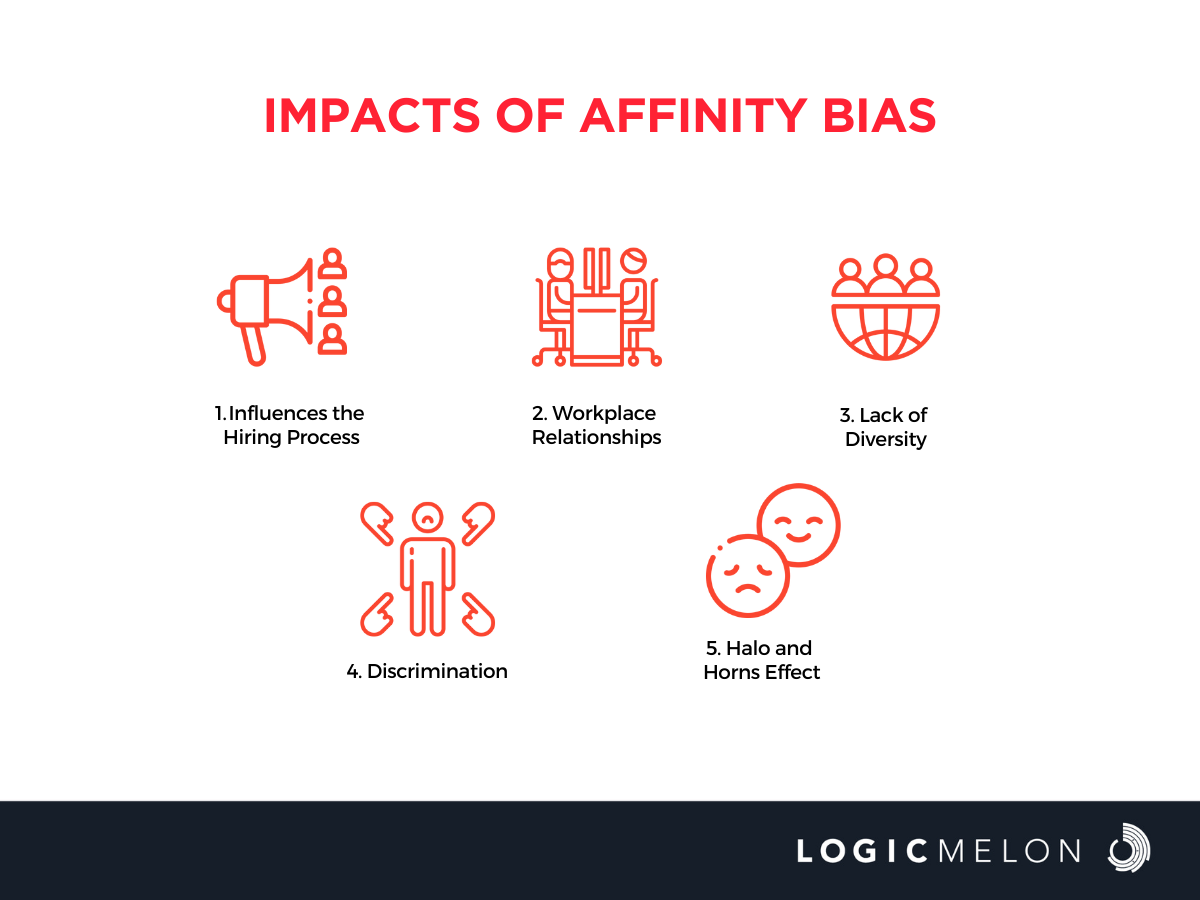What is Affinity Bias and How to Overcome It
Affinity bias, also known as the similarity bias in the workplace and is the tendency for people to favor others who share similarities with them.
Favoring those who have similar interests and backgrounds can lead to unconscious bias in recruitment. This is why we need to understand and overcome affinity bias.
The term used in neuropsychology to describe how we subconsciously gravitate towards people with whom we feel and share our interests, beliefs, and backgrounds is called affinity bias. As human beings, we often consider ourselves a great judge of character, which can lead to the halo or the horns effect.
This bias is unconscious in nature where people gravitate toward others who appear similar to them. The types of unconscious bias are confirmation, affinity, gender, halo, attribution, beauty, conformity, horn, age, contrast, authority, and similar basis.
Impacts of Affinity Bias

1. Influences the Hiring Process
Affinity basis affects the workplace because it can prevent hiring qualified professionals, which can lead to unequal treatment of professionals within an organization.
The hiring process can be influenced by favoring the person who has similar or common interests, beliefs, and backgrounds, rather than the person who is well trained and qualified for doing the work can create interviewer bias.
2. Workplace Relationships
Affinity bias can affect the relationship with previous employees working in the organization since they might feel that you are treating them in an unequal manner in the recruitment process.
3. Lack of Diversity
The employees joining the organization can come from similar interests and background affects the diversity in the organization thereby causing affinity bias, which can impact the relationship with people in the company. Candidates with different interests and backgrounds can reduce affinity bias because the people are not similar to each other. They can consider other factors, such as qualifications, and personality for appointing them a role in the company.
4. Discrimination
Affinity bias creates an unfair or prejudicial judgment of people and groups based on certain characteristics, such as race, gender, or sexual orientation. If someone discriminates in order to satisfy another person’s wishes, it is also discrimination.
5. The Halo and Horns Effect
The halo effect is for the positive impressions of a person, company, brand, or product in one area to positively influence the opinion or feelings in other areas. The horn effect is a cognitive bias that happens when you make a quick judgment about someone on the basis of one negative trait. The halo effect is the cognitive bias that causes you to have a positive feeling (halo), and the horns effect is bad, which is the negative feeling (horn) to judge people based on surface-level impressions.
How to Overcome Affinity Bias?
It is possible to overcome similarity bias in the following ways:
1. Seek Diversity
Diversity is the difference that shapes our view of the world, our perspective, and our approach. Diversity is important to avoid affinity bias, since affinity encourages people with similar interests, beliefs, and backgrounds, whereby diversity eliminates this kind of similar interests and backgrounds by exploring diversified options, such as different perspectives, interests, and backgrounds.
2. Set Expectations
By setting expectations, the company can make sure employees understand that your company values diversity, and should include a diversity statement in your organizational values, demonstrating your commitment to diversity. The people in the company who do not meet the expectations can be identified and you can take action.
3. Make Leaders Responsible
Leaders in the organization are the people who make the decisions to recruit people based on factors, such as qualifications, background, and beliefs, and ensure that decision-makers are accountable for the organization’s values can demonstrate the importance of an unbiased workplace to the organization’s culture.
4. Evaluate Qualifications and Performance
A performance evaluation is a systematic process to determine how well the employees are performing their jobs. Evaluating the performance of the employees in the organization gives you a gimps of how the recruited people work on projects. The company can avoid affinity biases by evaluating work productivity and performance and eliminating the people who perform below the standards.
5. Raise Awareness
Awareness raising is the process of seeking information and informing people about affinity bias. Raising awareness helps people to have knowledge about the issues caused due to affinity bias. This process of raising awareness can be done through webinars, presentations, and by networking.
Frequently Asked Questions (FAQs)
1. How is affinity bias formed?
Affinity bias, also known as similarity bias, is the tendency of people to connect with others who share similar interests and experiences and have similar backgrounds. When companies hire for cultural fit they can fall prey to affinity bias.
2. What is the impact of affinity bias in the workplace?
Affinity bias can impact the promotional process when leaders promote people they’re familiar with, and who may lack the essential qualifications that some other team members may have.
3. How does diversity help to overcome affinity bias?
Diversity helps to avoid affinity bias, and can actively take note of the similarities, concrete skills, experiences, and unique qualities that contribute to your team as a “culture add” rather than a “culture fit.”
4. How do you overcome affinity bias in the workplace?
The first step in avoiding affinity bias is recognizing that affinity bias is unavoidable to humans, but you should be aware that you cannot and shouldn’t hire on a feeling basis alone, but should consider other factors. Affinity bias can be reduced when seeking diversity, setting expectations, making leaders responsible, evaluating qualifications and performance, and raising awareness in the workplace.
Closing Thoughts
Affinity bias known as similarity bias is the tendency to connect with people who have common or similar interests, experiences, and backgrounds. Favoring those who have similar interests or backgrounds can lead to unconscious bias in recruitment. Affinity bias can lead to the horn effect, which is a cognitive process in which people have a negative view of someone based on surface-level impressions.
The interview process for job candidates should be decisions based on factors, such as qualifications, personality, and background, rather than giving preference to candidates with similar interests, which causes affinity bias in the workplace. This causes a lack of diversity and can affect the relationship with employees in the workplace.
LogicMelon
Award-winning recruitment software that will find, attract, hire and analyse the way you want to work. At LogicMelon, we have experienced software recruitment marketing specialists to help you build effective recruitment solutions supported by the best customer service you’ll find anywhere!
Email: sales@logicmelon.com or call LogicMelon (UK) +44 (0) 203 553 3667 (USA) +1 860 269 3089
10 Tips For Recruiter Training
Organizations must have an efficient recruiter training plan for professionals if they want to hire the best candidates.
What is BARS Management(Behaviorally Anchored Rating Scale)
Behaviorally Anchored Rating Scale known as BARS is a method of performance management designed to measure employee performance to rate them.
How can Recruitment Analytics Improve the Hiring Process
Recruitment analytics is a combination of data and analysis that drives efficient hiring decisions. Read the article to know more.


